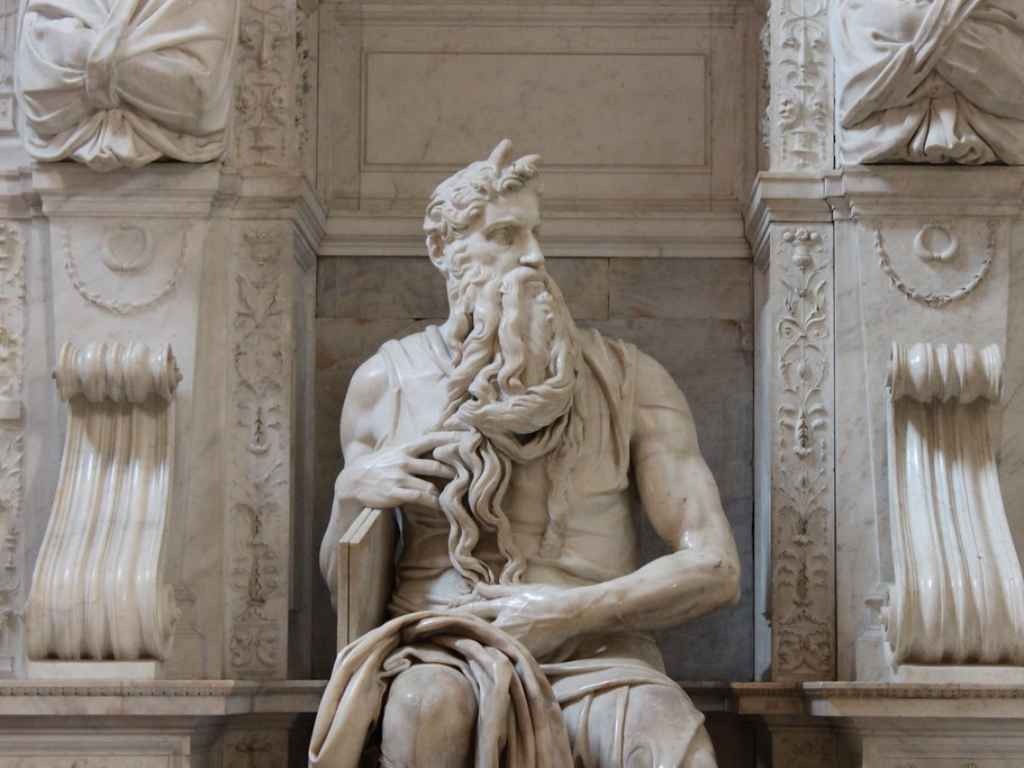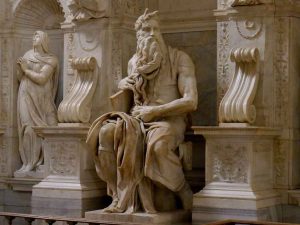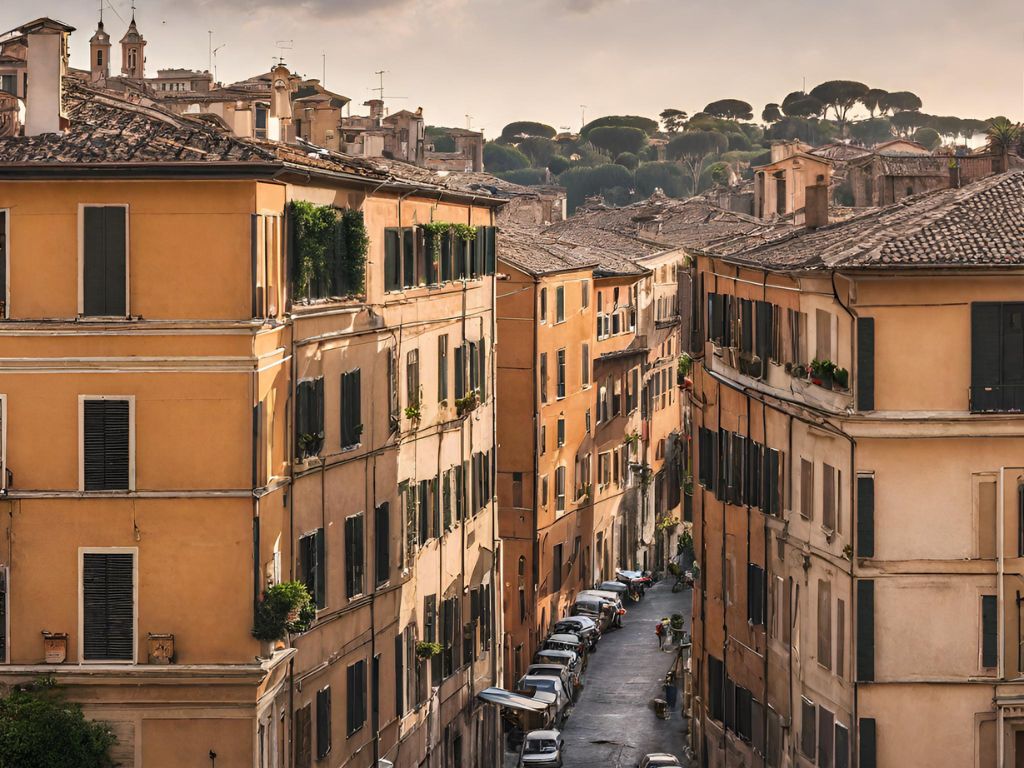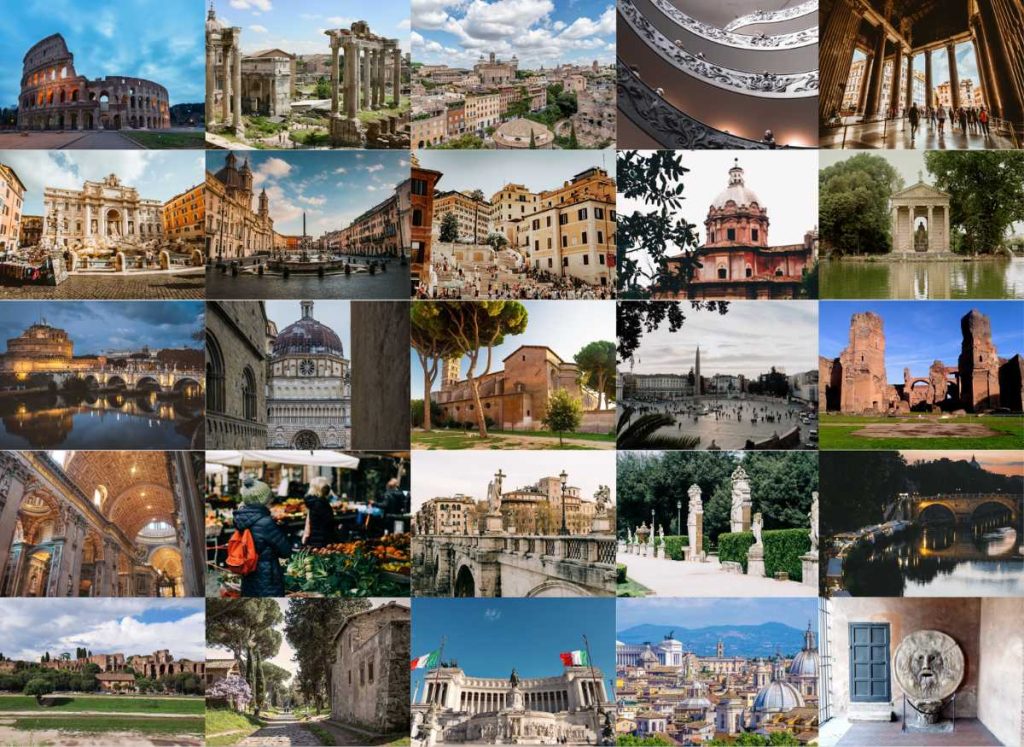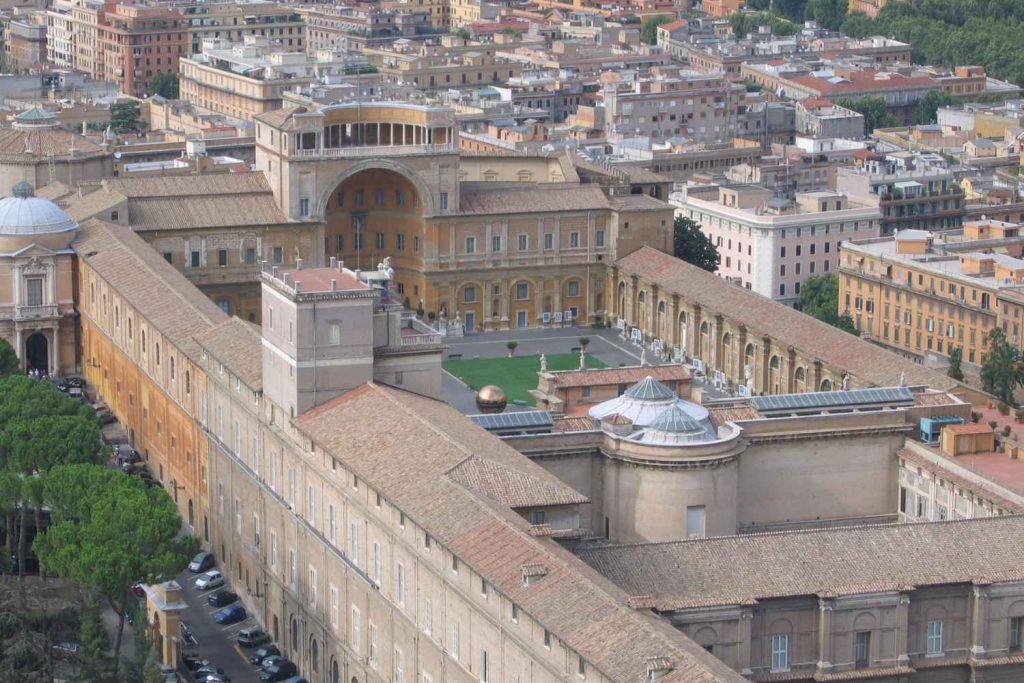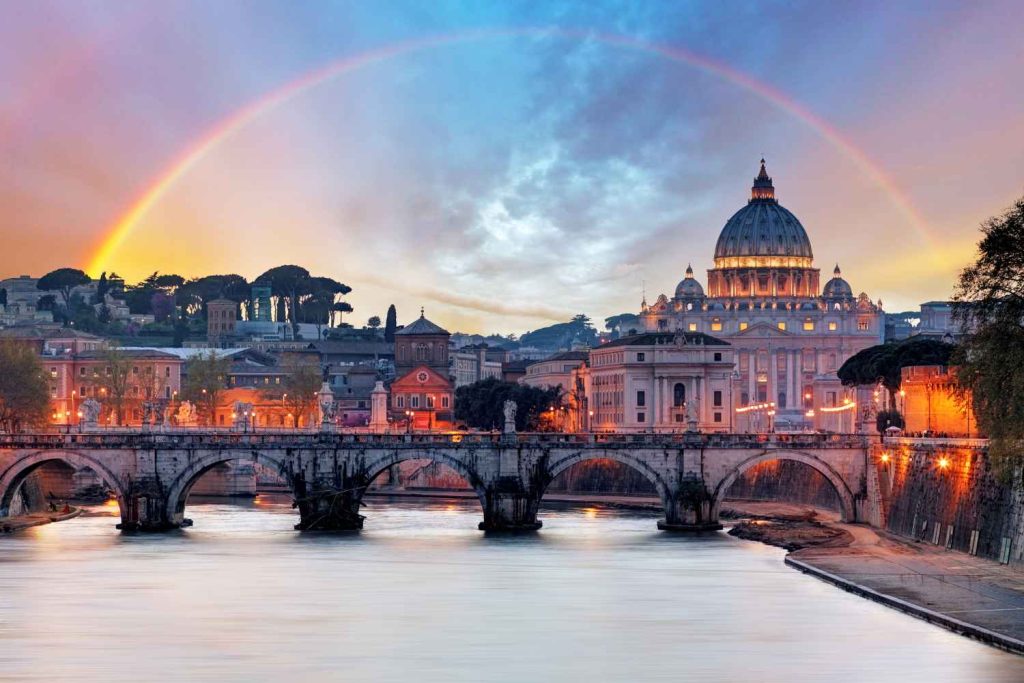Michelangelo’s Moses is a stunning masterpiece that not only showcases the genius of the sculptor but also serves as a testimony to the mastery of the Italian High Renaissance.
Housed in the church of San Pietro in Vincoli, this magnificent work of art has captured the admiration of countless generations, portraying the biblical character of Moses in a breathtaking depiction.
The church of San Pietro in Vincoli, located in Rome’s picturesque Rione Monti, has been a significant religious site since its founding and is also known for holding the chains of St. Peter. However, it is Michelangelo’s Moses that draws numerous art lovers to this ancient edifice. Created between 1513 and 1515, this intricate marble sculpture stands 235 centimeters tall and is part of the Tomb of Pope Julius II.
While the church itself is an architectural marvel, there’s no denying that it’s this larger-than-life sculpture that truly captures the essence of Michelangelo’s genius and leaves visitors awestruck. Combining his extensive knowledge of anatomy with his remarkable artistic ability, Michelangelo succeeded in capturing the essence of Moses for the world to appreciate.
The Masterpiece of Michelangelo

Michelangelo’s Moses is a magnificent marble sculpture that showcases the artist’s incomparable talent and ability to infuse life into stone. Created between 1513 and 1515, the statue is housed in the beautiful church of San Pietro in Vincoli in Rome. The church itself is a treasure trove of history and art, yet it’s Michelangelo’s masterpiece that captivates all who come to visit.
The decision to depict Moses in such a grand manner was not only to honor the revered prophet but also to convey his extraordinary energy and passion. As a result, Michelangelo chose to use marble, a material known for its durability and versatility. With careful attention to detail, he was able to craft the sculpture in such a way that the viewer could sense the tension, power, and determination that radiate from Moses.
As part of the tomb of Pope Julius II, Michelangelo’s statue was intended to be part of a larger structure. However, the artist’s intense focus on the creation of Moses led to the modifications, placing the figure as the centerpiece of the tomb. Moses, sitting on a marble chair against a backdrop of decorative pillars, presents a grandeur and nobility befitting his role as a prophet.
The beauty of Michelangelo’s work lies in its ability to capture human emotion and natural forms. This is evident in Moses’ face, a juxtaposition of strength and vulnerability. The powerful muscles of his arms and the veins that ripple beneath his skin show the intensity of the prophet’s being while the soft expression of his eyes portrays a sense of introspection.
Michelangelo successfully used the inanimate material of marble to personify Moses in this sculpture. The attention to detail, the unparalleled craftsmanship, and the merging of human emotion with the subject’s religious significance all contribute to the enchanting beauty of this iconic work of art.
In conclusion, Michelangelo’s Moses stands as a testament to the artist’s skill and talent in transforming marble into a vivid expression of human emotion and power. The statue, housed in the charming church of San Pietro in Vincoli in Rome, continues to inspire awe and wonder in all who view its stunning artistry and craftsmanship.
Church of San Pietro in Vincoli
The Church of San Pietro in Vincoli is a basilica located in Rome, Italy, near Via Cavour and Piazza di San Pietro in Vincoli. This church is famous for housing Michelangelo’s Moses sculpture, and it is also notable for its historic and artistic value.
The basilica’s interior features a nave and two aisles, separated by antique Doric columns that support the structure. The aisles are surmounted by cross-vaults, while the nave boasts an 18th-century coffered ceiling, with the center frescoed by Giovanni Battista Parodi and portraying the Miracle of the Chains (1706).
Besides Michelangelo’s Moses, the church is known for holding the two chains (vincoli) believed to have tethered St. Peter the Apostle during his imprisonment in Rome. These chains are said to be displayed on the altar in the church.
Visitors to the Church of San Pietro in Vincoli can appreciate the historic and architectural features while admiring the marvelous artwork and relics contained within the basilica. Additionally, the surrounding area of Rione Monti offers a glimpse into the beautiful and popular aspects of Rome.
Historical and Biblical Context
The sculpture of Moses by Michelangelo, located in the church of San Pietro in Vincoli in Rome, has both historical and biblical significance. Commissioned by Pope Julius II around 1513-1515 as part of a tomb project, it is considered one of the masterpieces of Michelangelo’s High Renaissance period.
Moses, a significant figure in the Exodus story, was chosen by God to lead the Israelites out of slavery in Egypt. While on Mount Sinai, he received the Ten Commandments, inscribed on two tablets of stone. The statue depicts Moses holding these tablets while contemplating the Golden Calf episode, a critical moment when the Israelites rebelled against him and God’s law. Michelangelo’s portrayal of Moses invokes this moment of leadership and humanity, solidifying him as a prominent figure in biblical history.
San Pietro in Vincoli was built in the 5th century by Empress Eudoxia to house a precious relic: the chain that is believed to have fettered St. Peter as a prisoner in Jerusalem. This chain is currently preserved under the high altar and exposed to the faithful on August 1st of each year.
It is worth noting that the Hebrew word “horns” was used in the Vulgate Bible to describe the beams of light emanating from Moses’ face when he descended from Mount Sinai. This led to a popular misconception that Moses had physical horns, which has been depicted in some artworks throughout history. Michelangelo, however, chose not to include horns on his statue of Moses, opting for a more realistic representation.
In summary, Michelangelo’s Moses in San Pietro in Vincoli serves as a reminder of the historical and biblical significance of the Exodus story and the pivotal role that Moses played in leading the Israelites to freedom. This remarkable sculpture pays tribute to the strength, wisdom, and unwavering faith of this iconic biblical figure.
Architectural Detail and Symbolism
The Enigmatic Horns
One of the most striking elements of Michelangelo’s Moses sculpture is the enigmatic pair of horns on Moses’ forehead. The origins of this depiction can be traced back to the mistranslation of a biblical text in the Latin Vulgate, where the Hebrew word ‘karan’ (meaning radiant or shining) was mistakenly translated as ‘keren’ (meaning horns). As a result, Moses became symbolically represented with horns, a detail that Michelangelo masterfully incorporated into his marble sculpture.
The Statue’s Pose
The Moses statue portrays a seated figure with a muscular physique, conveying energy and authority. Moses’ left leg is crossed over his right with his left foot firmly placed on the ground. His right hand holds his flowing beard, while his left arm clutches the Tablets of the Law. This dynamic pose suggests a sense of readiness to rise, emphasizing the sculpture’s powerful presence.
Handling of the Tablets
In the sculpture, Moses firmly holds the Tablets of the Law, inscribed with the Ten Commandments given to him by God. The tablets are slightly curved, as if they were made of a more pliable material rather than stone. This visual effect showcases Michelangelo’s skill in conveying the monumentality of the tablets, while also expressing the divine origin of their content.
The overall architectural details and symbolism of Michelangelo’s Moses sculpture demonstrate the artist’s unparalleled craftsmanship and understanding of spiritual significance. In capturing the enigmatic horns, the dynamic pose, and the handling of the tablets, Michelangelo created a marvel that stands as one of the greatest masterpieces of Italian art.
Connection with Other Works and Artists
Michelangelo’s Moses in San Pietro in Vincoli is an excellent example of a high Renaissance masterpiece in Rome. Completed around 1513-1515, this marvelous statue is known to have connections with other artists and works from the same period.
One evident connection can be seen with Michelangelo’s contemporary, Donatello, who was also a major influence during the Renaissance. Both artists employed bold and expressive sculptures to depict biblical figures, often showcasing their physical strength and intense emotional states. As a result, their works have become symbols of the artistic innovation witnessed during the high Renaissance.
The Moses statue was created for the tomb of Pope Julius II, one of Michelangelo’s primary patrons, and a significant figure in Rome’s development during the time. Julius II’s ambitious vision for Rome led to many significant architectural and artistic projects, including the construction of St. Peter’s Basilica and the famous frescoes in the Sistine Chapel by Michelangelo.
Another connection between Michelangelo’s Moses and other artworks is the depiction of prophets and biblical figures. At the time, artists like Michelangelo were tasked with creating monumental sculptures and mosaics that narrated religious stories, demonstrating their mastery of portraying emotional depth and complexity in their subjects. This artistic trend can be seen in works by Guercino, Domenichino, and Parodi. For instance, Italian painter Giovanni Battista Parodi used a similar intensity in his frescoes, which also featured religious and prophetic themes.
In addition to its connections with other works, Michelangelo’s Moses also has strong ties with Paris, as the French architect Hector Lefuel, responsible for the renovations of the Louvre Palace during the Second Empire, was deeply influenced by Michelangelo’s art. The grandiose style and artistic mastery seen in Michelangelo’s work, including the Moses statue, significantly impacted Lefuel’s designs.
In conclusion, Michelangelo’s Moses serves as a testament to the rich artistic heritage of the high Renaissance period. It not only showcases the artist’s own skills and expertise but also highlights the influence of his contemporaries and the broader cultural context in which these masterpieces were created.
If you want to know more about other masterpieces in Rome, check out our article on Galleria Borghese in Rome, an Art Lover’s Paradise.
The Legacy of Michelangelo’s Moses
Michelangelo’s Moses is a masterpiece of the Italian High Renaissance, housed in the church of San Pietro in Vincoli in Rome. The statue conveys a sense of energy and passion, demonstrating Michelangelo’s genius in sculpture.
The statue represents the biblical figure Moses, holding the Tablets of the Law. Michelangelo’s attention to detail and ability to sculpt lifelike forms is evident in the intricate features of Moses’ face, beard, and musculature. The beauty of this monument is often considered to be unmatched, setting a new standard for artistic creations of its time.
Moses was initially designed as part of the tomb of Pope Julius II, a monumental project that Michelangelo never completed fully. Although the grand plan of the tomb was ultimately reduced, Michelangelo’s Moses became the centerpiece of this iconic tomb. This sculpture also sparked a specific legend associated with the artist: it is said that upon completing the statue, Michelangelo struck Moses’ knee, commanding him to speak, as a testament to the lifelike quality of his creation. The supposed mark of Michelangelo’s hammer remains visible on the sculpture’s knee today, symbolizing the artist’s dedication and the vigorous energy infused into the statue.
Michelangelo’s Moses has continued to inspire artists, scholars, and audiences over the centuries. Its presence in the church of San Pietro in Vincoli draws countless visitors, eager to witness the striking beauty and emotional power of the masterpiece. Conveying a unique blend of spirituality and physicality, the Moses statue has left a lasting impact on the world of art and demonstrated Michelangelo’s timeless legacy.
More articles you might like...
You can find more great Rome content in the following categories;
All about Vatican City Commonly Asked Rome Questions Rome Accommodation Rome Food and Drink Rome History and Culture Rome Neighbourhoods Rome Tours and Must-See Attractions
